Native Son – June, 2009
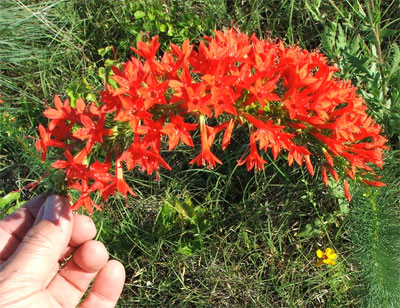
The author bends a single stem of standing cypress toward the camera. All photos by Steven Chamblee.
Gratefulness
Road Trip Straight to the Heart
Slid on down good ole Tin Top Road today, again. That road is like an old cotton shirt to me — familiar and comfortable. On the surface, I was taking the scenic route to give a talk to the Lake Granbury Master Gardeners. Little did I know I was headed straight down Memory Lane.
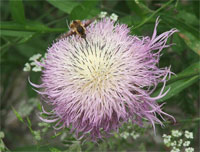
Basket flower
(Centaurea americana)
A nice stand of basket flower (Centaurea americana) brought my truck to a quick stop right beside that little road that sneaks out the back of Tin Top Estates, where a friend of mine used to live. (I’ll never forget the dock out back of the house that sticks out into a finger of Lake Granbury that sneaks through the neighborhood. I said it looked rickety; she said it was fine. Three steps and one “snap!” later, the whole thing is doing a slow-motion sideways slide into the water. I did a fast-motion retreat and managed to go in only to my knees, but since I was barefoot, I was worried one of those monster snapping turtles would mistake my toe for an hors d’oeuvre. Screamed like a little girl at a 1975 Donny Osmond concert … so much for my machismo.) Basket flower grows over a large portion of Texas, and is named for the basket-like appearance of the receptacle that holds the flower (technically, about a hundred individual flowers that grow as one mass.) Basket flower often suffers from misidentification, as its lovely lavender, pink, and sometimes white flowers are similar to thistle, and it is frequently mowed down by people with the best of intentions. And for the record, there’s not a prickle anywhere on the whole plant.
Coming back to Weatherford, I passed the stately old escarpment live oak that I wrote about in e-gardens a year or two back. Sad to say, it was struck by lightning about four months after the article ran, and quickly succumbed to the damage. It still stands proudly, as it has for about two centuries, though now leafless and lifeless. I guess I was lucky to meet it before it passed, which made me think of the late “plant hunter” Benny Simpson, whom I got to know during the last year of his life. Carpe diem, indeed, for who knows where lightning strikes next.
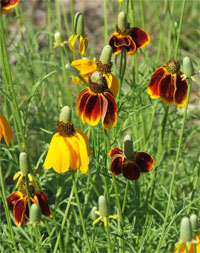
Mexican hat (Ratibida columnifera)
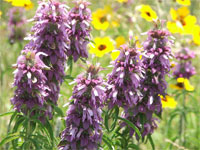
Horsemint (Monarda citriodora)
My mind drifts to my trip out to Graham about two weeks back — another speaking engagement, this time to a fledgling chapter of the Native Plant Society of Texas (check out www.NPSOT.org). Great folks, great minds, great town, and apparently the largest town square in the state, which sports many cool renovations. Several miles south of town, you can see a “windmill ranch” off in the distance, where clean and green electricity is being spun up 24/7. There were plenty of bar-ditch beauties along the way, including Mexican hat (Ratibida columnifera) and horsemint (Monarda citriodora). My talk went long that evening, but the crowd hung in there, eager for every tidbit of info I could deliver. I really appreciate that, and consider it a great compliment when the group is more concerned with learning about plants than where the little hand is pointing. I got a distinct positive vibe from this little town, as if it is destined for true greatness — like to the feel of Austin in the 1970s. The moonlit drive home gave me time to think about how fortunate I am to live in Texas, where a little town can determine its own destiny, and the roadsides are like rainbows.
Perhaps the best wildflower stretch this year has been the first 10 miles west of Weatherford. I go out to Brock quite often, and take the I-20 access road to avoid all the traffic and hassles. I can still drive 60 mph, but I can stop on a dime when I see something interesting … and there is a lot of interesting stuff out there. Bluebonnets, Indian paintbrush, Texas blue star, pallid yucca, four point evening primrose, pink evening primrose, black-eyed Susan … oh heavens, it just goes on and on.
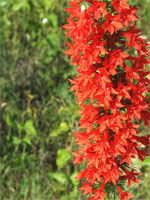
Standing cypress (Ipomopsis rubra)
So I went out to give a talk at the W.K. Gordon Museum in Thurber a few weeks back, and discovered the amazing treasures that existed just beyond the Brock exit. The first was one of the finest stands of standing cypress (Ipomopsis rubra) I’ve ever seen. This biennial grows into a fuzzy, baseball-sized clump the first year. The second year, it extends up 3 to 4 feet tall into roughly a baseball-bat-shaped plant (skinny at the ground, and getting fatter as it goes up), and is absolutely smothered in bright red-orange flowers. You just can’t help but dance around like a five-year-old birthday boy when you get around these things, and I got several honks from concerned truckers over on the freeway who apparently aren’t accustomed to seeing a 49-year-old man prancing around in the wildflowers. Good thing the sheriff was busy elsewhere….
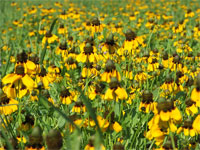
Clasping-leaf coneflower
(Dracopis amplexicaulis)
Another mile down the access road, and there is a field of clasping-leaf coneflower (Dracopis amplexicaulis). Literally and aptly describing the way the leaf base curves around, or “clasps” the stem, the scientific name translates to “embracing stem.” These are one of the prettiest DYC’s you’ll find in Texas, and they grow fast, often forming colonies so thick that nothing else can grow underneath them. By the way, the term DYC (darn yellow composite), is sort of an old-timers’ botanist term coined because there are so many yellow-flowered “composites” out there that they become confusing, even to experienced plant people. A “composite” flower is made up of several distinct parts (usually disc and ray flowers) that superficially resemble a single daisy-type bloom. Most are members of the aster family.
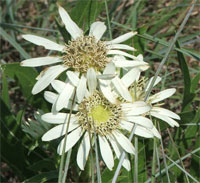
White-flowered rosinweed (Silphium albiflorum)
Another few miles and it’s white-flowered compassplant (Silphium albiflorum) dotting the roadside. The funny name comes from the idea that the very stiff, cardboard-like leaves are always oriented north and south. Not that I believe all this pioneer folklore, but in this case, the leaves were doing just that. (Someone once told me sweetgum trees were named so because the springtime twig bark was used as a substitute for chewing gum … by “the pioneers,” of course. So I tried it. Save yourself some trouble, folks, and just stick your tongue directly into a bucket of turpentine. Nasty stuff … no pioneer was ever that desperate.) Come to think of it, the other common name for white compassplant is white rosinweed, for the sticky resin that oozes from the stems and leaves. I decided not to taste it.
The rest of the trip was just perfect, including my requisite stop at the Brazos River Catfish Café. I may hate myself for letting the cat out of the bag on this local secret, but this place rocks! (I-20 west to the Milsap exit and follow the access road west to the river. Thursday through Saturday, 5 p.m. – 9 p.m.; Sundays, 11 a.m. – 3 p.m. Cash only, no cards, tip heavy. Personally, I order 3 Cajun, 1 Memphis, and 1 Regular. Don’t forget to put tartar sauce in the to-go box. Snag a jar of pickled green tomatoes for the in-laws, and ask for a lemonade iced tea to go for the road ahead.)
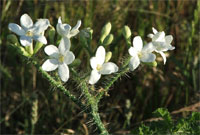
Bull nettle (Cnidoscolus texanus)
Yes, I eventually arrived at the museum. So I get to the part in my talk about “not every native plant is garden worthy.” A nice gentleman takes me to task on this, pointing out that every herb has its place. So I start the description…, “Indestructible herbaceous perennial; capable of surviving any drought because of an 8-inch-thick, branching taproot; beautiful, dark green, palmately-lobed leaves; lovely, pure white, incredibly fragrant blossoms….” Suddenly, from the back of the room, comes an experienced female voice…, “Sounds like bull nettle to me!”
Case closed … and I hadn’t even gotten to the poison ivy yet.
This article is dedicated to my dear friend and neighbor, Lonnie May (1927-2009). Known to many folks around Weatherford simply as “The Clock Shop Man,” Lonnie was a kind and gentle octogenarian who knew the value of family, fresh eggs, and a really good home-grown tomato.
About the author: Steven Chamblee is the chief horticulturist for Chandor Gardens in Weatherford and a regular contributor to Neil Sperry’s GARDENS magazine and e-gardens newsletter.
A little help from my friends…
I still need some destinations for my Texas road trips! If you would like me to speak to your garden club or group, just shoot me an e-mail at schamblee@weatherfordtx.gov to make arrangements. I’m inexpensive and low maintenance, and you know I love to go just about anywhere, so let me know. No city too big; no town too small. As long as it has a Farm to Market road nearby, I’m in.
Visit Chandor Gardens
Summer means it’s time to travel. Plan your visit to historic Chandor Gardens now. We have made lots of changes this past year, so if you haven’t seen Chandor Gardens lately, you just haven’t seen Chandor Gardens! We’ve got heirloom color plants, waterfalls, fountains, sculpture, grottoes, a labyrinth, and more. You can go to the website (www.chandorgardens.com) for a preview and call 817-613-1700 for reservations and more information. Combine your Chandor trip with an afternoon visit to nearby Clark Gardens (www.clarkgardens.com) for a full day of blooms and beauty.
